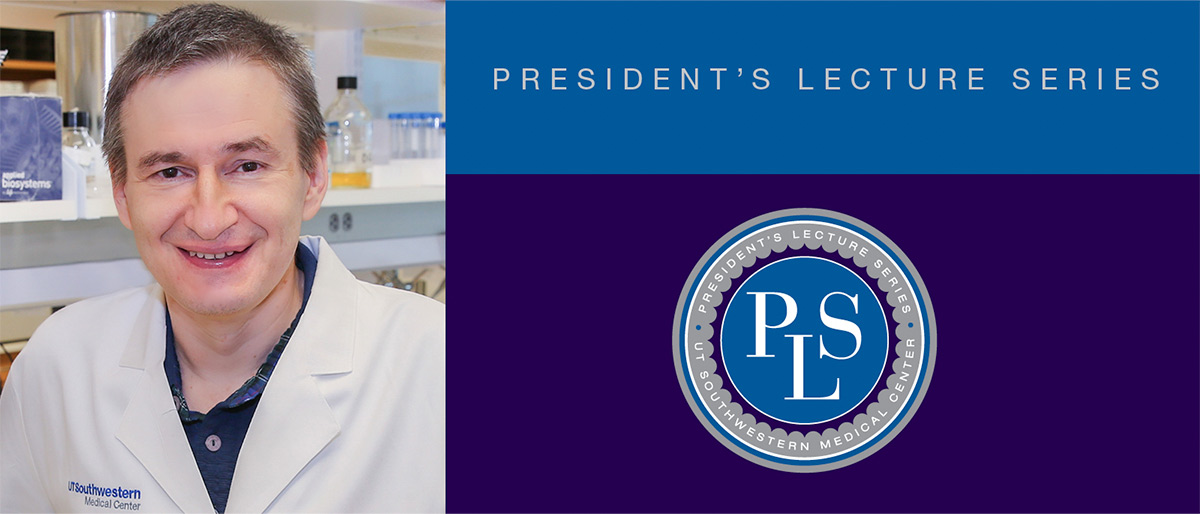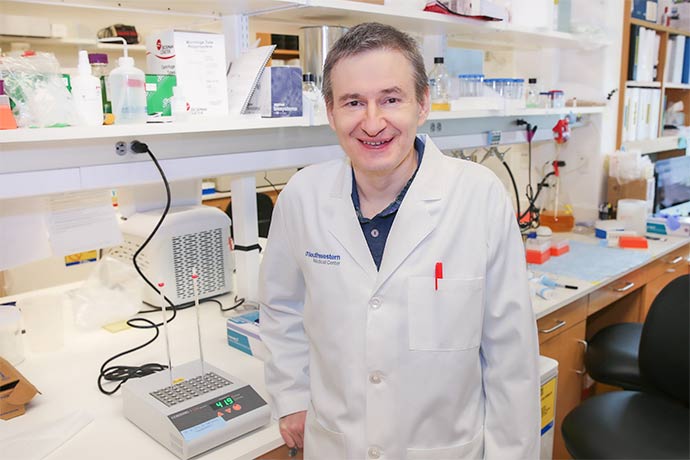President’s Lecture Series: Using modern tools to capture the secrets of life in your hand

Nick Grishin, Ph.D., is a lepidopterist, meaning a person who studies butterflies or moths. Through his research, his ambitious goal is to decipher and categorize the genetic underpinnings of life – from the tiniest fluttering moth to the burliest human.
A Professor of Biophysics and Biochemistry, Dr. Grishin will present the next President’s Lecture virtually at 4 p.m. Thursday, Feb. 24, in a talk titled “Computational Adventures in Biomedical Sciences: From Molecules to Butterflies.” The presentation will be available at utsouthwestern.edu/pls.
Dr. Grishin uses modern computational methods to build entire genomes – or genetic maps – of the moths and butterflies he studies. His work relies on technology to help identify the proteins that genes encode and the ways those proteins function in different species.
If the study of moths and butterflies seems far afield from the secrets of human life, Dr. Grishin begs to differ. “Butterflies have 15,000 genes. Humans have 20,000 genes. But all the basic genes are the same,” he said. “There are no proteins I know of in humans that are really that different from proteins in butterflies. These are all connected through evolution.”
Dr. Grishin grew up in Russia, the son of college mathematics professors, and received his Diplom (the equivalent of a bachelor’s plus a master’s degree) in biochemistry from Moscow State University. He earned his Ph.D. in molecular biophysics from UT Southwestern in 1998.

In 1991, while in college in Moscow, Dr. Grishin sequenced his first molecule, a bacterial enzyme, using what was then the state-of-the-art Sanger sequencing method, named for two-time Nobel Prize winner Frederick Sanger, Ph.D. In 1977, Dr. Sanger developed a way to sequence, or decode, DNA into its pattern of nucleotides (A’s, C’s, G’s, and T’s). Back then, genomic sequencing was done in test tubes, one molecule at a time.
Today, UT Southwestern and other leading research centers have machines that can sequence hundreds of thousands of genes within hours. Powerful computers can compare the genomic sequences found to those in known proteins and create a molecular image that can be studied in detail.
“It’s basically like video games where, instead of chasing some enemy, you chase the protein,” said Dr. Grishin. “You look at it. You increase it in size. You rotate it around. You try to see where the functional place on it is and how it does what it does with that functional place that people call an ‘active site.’”
More and more, researchers are reaching for such high-tech computational tools to quickly analyze genetic data rather than sitting at a bench with a microscope and performing traditional experiments, he said.
One day – perhaps 40 or 50 years from now – drug companies will use computers to quickly sift through promising molecules to uncover a drug rather than do the random searches performed in labs now, Dr. Grishin predicted – and some clinical trials may be rendered unnecessary by computerized models that can predict which human cells a molecule would enter and what its effect would be. “It takes billions of dollars to make a drug now,” he said. Successfully shifting this process to computers could reduce that cost tenfold or more, Dr. Grishin said.
In his lab at UTSW, Dr. Grishin studies the sequenced genomes of hundreds of moths and butterflies and analyzes the functions of the proteins encoded and how proteins from various species might be related or the product of evolution.
He also collaborates with other researchers. A few years ago, he worked with Don Gammon, Ph.D., Assistant Professor of Microbiology, to sequence the genome of the gypsy moth, an invasive insect that has the largest moth or butterfly genome ever sequenced.
Dr. Grishin also consults with UTSW researchers eager for answers to basic science questions about a striking human protein or gene they have spotted.
He contributed to the work of Helen Hobbs, M.D., Director of the Eugene McDermott Center for Human Growth and Development, on PCSK9, a genetic mutation she found that protects against high cholesterol in humans and has become the basis for important cholesterol-lowering drugs. Dr. Hobbs is also Professor of Internal Medicine and Molecular Genetics and a Howard Hughes Medical Institute Investigator.
Dr. Grishin also helped Joseph L. Goldstein, M.D., and Michael S. Brown, M.D., two of UT Southwestern’s Nobel Prize winners, identify a protein that activates ghrelin, often called the “hunger hormone.” Dr. Goldstein is Chair of Molecular Genetics and Professor of Internal Medicine. Dr. Brown is Professor of Molecular Genetics and Internal Medicine.
One goal, Dr. Grishin said, is to understand protein evolution – “to basically classify all proteins based on how they originated.” That, he said, would allow a new type of biological classification of the species based on their genome and protein similarities. Understanding the genome on that level could one day allow doctors to see disease predispositions in individuals at birth so that diseases potentially could be prevented rather than treated.
“Instead of curative medicine as we have it today, medicine will be preventive because we will know what to expect,” Dr. Grishin said.
Dr. Brown, a Regental Professor, holds The W. A. (Monty) Moncrief Distinguished Chair in Cholesterol and Arteriosclerosis Research, and the Paul J. Thomas Chair in Medicine.
Dr. Goldstein, a Regental Professor, holds the Julie and Louis A. Beecherl, Jr. Distinguished Chair in Biomedical Research, and the Paul J. Thomas Chair in Medicine.
Dr. Gammon is a W.W. Carruth, Jr. Scholar in Biomedical Research.
Dr. Grishin holds the Cecil H. and Ida M. Green Chair in Biomedical Science and is a Virginia Murchison Linthicum Scholar in Biomedical Research.
Dr. Hobbs holds the Philip O’Bryan Montgomery, Jr., M.D. Distinguished Chair in Developmental Biology, the Eugene McDermott Distinguished Chair for the Study of Human Growth and Development, and the 1995 Dallas Heart Ball Chair in Cardiology Research.

